How to get the perfect pantry
A pantry is top of many homeowners’ kitchen wish lists. So we asked the experts for their top tips for pantry design
A pantry is a small room used to store food, usually attached to or just off the main kitchen. The origins of the word lie in the Latin word for bread “panis”. From this derived the Old French word “paneterie” meaning “cupboard where bread was stored”. In mediaeval English, this had become “panetrie”. Today, other options are tall, freestanding pantry cupboards, and built-in pantries incorporated into kitchen cabinetry.

Image credit: Nkuku
Pantry vs larder
What about larders? In the Middle Ages, the larder was the place where meat that had been preserved in lard was stored. Traditionally, larders were cool rooms or cupboards used to store more perishable items. Nowadays, many people use the two words interchangeably.

Image credit: Mowlem & Co
The modern pantry
Charlie Smallbone of Ledbury Studio says, “The concept of the pantry has evolved significantly over the years. Traditionally a space for storing food, the modern pantry has expanded its role to include a variety of functions, from keeping wine cool to housing kitchen gadgets, and even acting as a secondary prep kitchen. This flexibility has made the pantry a kitchen essential, adaptable to numerous spaces and needs.”
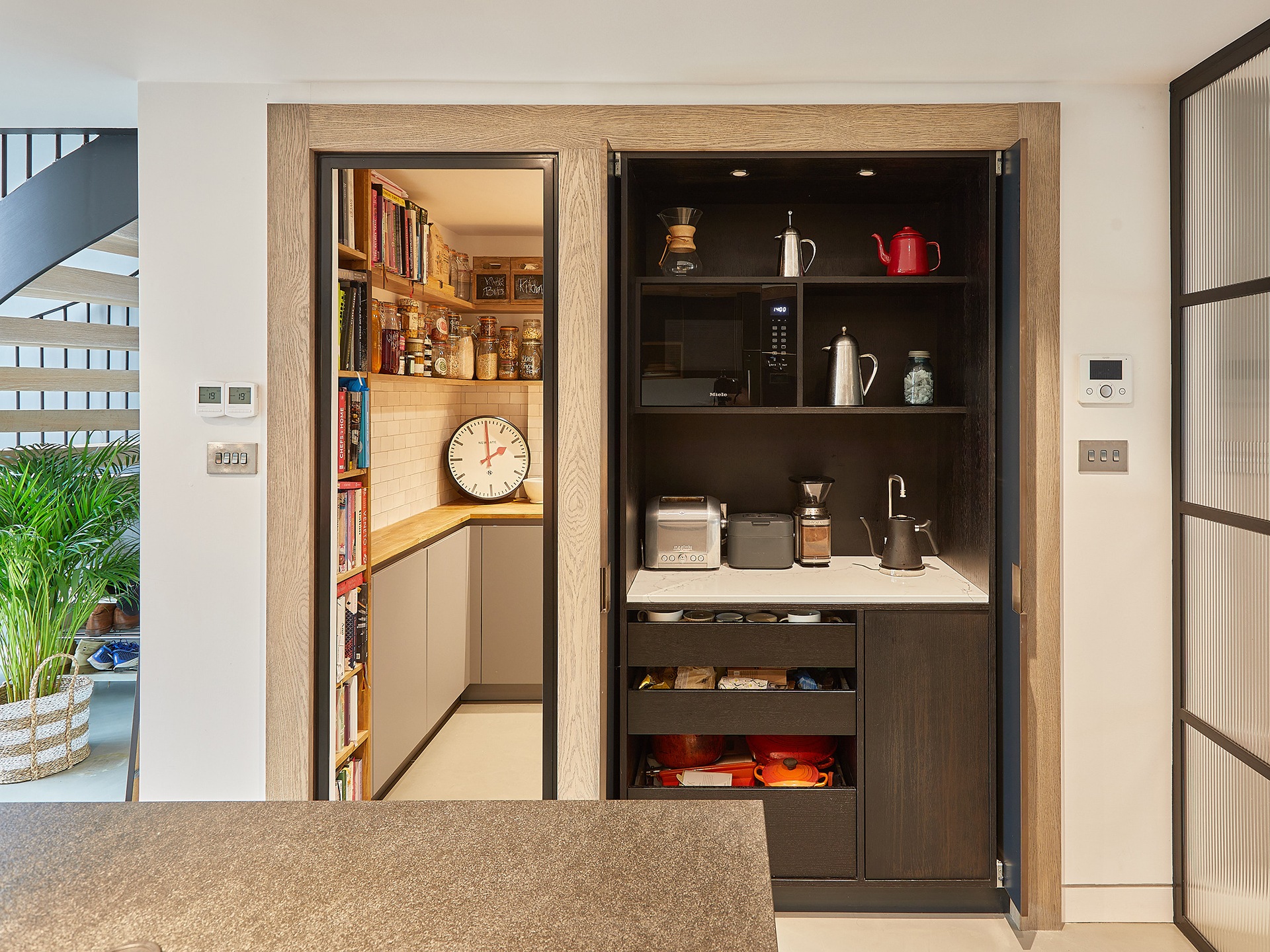
Image credit: Kitchens by Holloways
Rob Falconer, from ProCook, adds, “Anything that doesn’t need to be refrigerated can be stored in a pantry, for example, herbs and spices, rice and flour. Any long-life items and unopened cans and jars are also great to store in a pantry. Something you wouldn’t always think about is unripe fruit and vegetables, which benefit from being kept in dark, dry conditions, or things like potatoes, which have great longevity when stored correctly.”
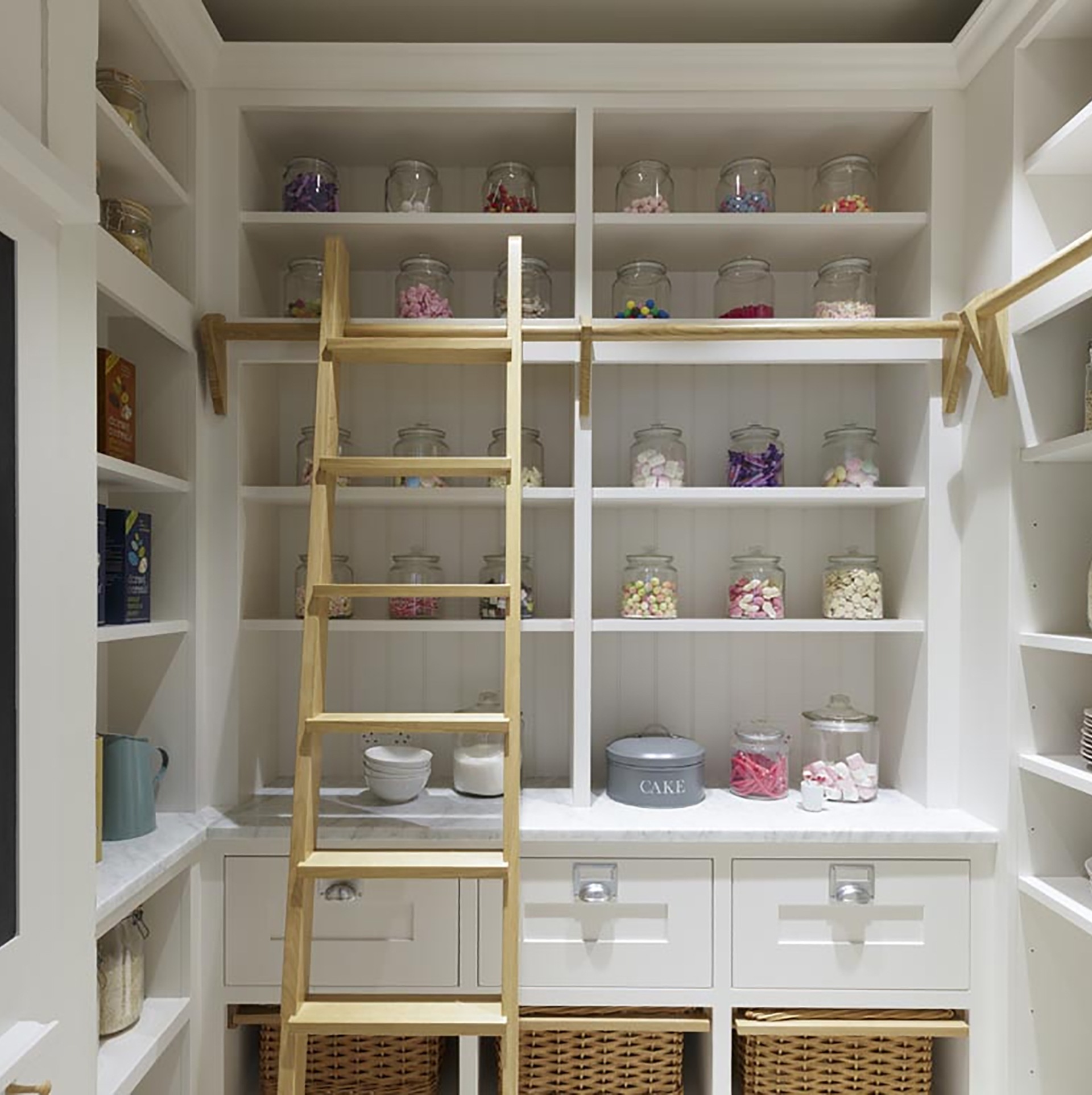
Image credit: Mowlem & Co
Separate room
If you’ve got the space a pantry in a separate room adjoining the main kitchen is ideal. As Charlie Smallbone says, “Walk-in pantries offer the largest storage capacity, perfect for bulk buying.”

Image credit: Kitchens by Holloways
Allison Lynch from Roundhouse advises, “Avoid warm spaces, as food can easily spoil. Good ventilation and light are needed. Lots of direct sunlight isn’t good as it increases the temperature in the room.”
If you are lucky enough to have the space for a separate pantry, go all in and equip it fully. Create a second mini “back” kitchen, with counter tops, a sink, and lots of sockets.
Pantry design
Charlie Smallbone says, “The main goal when designing a walk-in pantry is not just to create a storage space and free up the main kitchen, but to design a beautiful, functional room that truly enhances your day-to-day life. Larger pantries in particular are invaluable for storing masses of non-perishable groceries, but also brilliant for storing and using a multitude of countertop appliances that you perhaps don’t want to have accessible all the time but need on an occasional basis.”
Allison Lynch advises, “One of the biggest mistakes made when designing a small pantry is not allowing enough room for moving around when putting groceries away and bending down to reach shelves at base level. It’s essential to consider what items will be used regularly and sort them accordingly for ease of access.”

Image credit: Jonathan Gooch for Claire Garner Interiors
Louisa Eggleston from Humphrey Munson adds, “A mix of storage space is essential: artisan shelves are perfect for jars and tins, whilst a mounted spice rack keeps bottles and spices together, rather than scattered to the four corners of the kitchen.
“At the planning stage, make a list of everything you have and then work out where it makes sense to keep it. Keep everyday items in the main kitchen, and less frequently used items in the pantry.
“Sometimes the simplest of storage solutions are the best. For those less appealing larger items you can’t bring yourself to display, such as exploding bags of flour, deep drawers are the answer.”
Laura Price of The Home Organisation says, “When considering the layout of your pantry, the best way to keep it looking good is to make it as intuitive as possible. Heavy items should be lower down so they’re not difficult to put away. The items you use on a daily basis should be front and centre so you can grab them without effort. Similar items, like baking ingredients for example, should be kept together so you never need to go hunting for them, and you can put them away without thinking about it.”
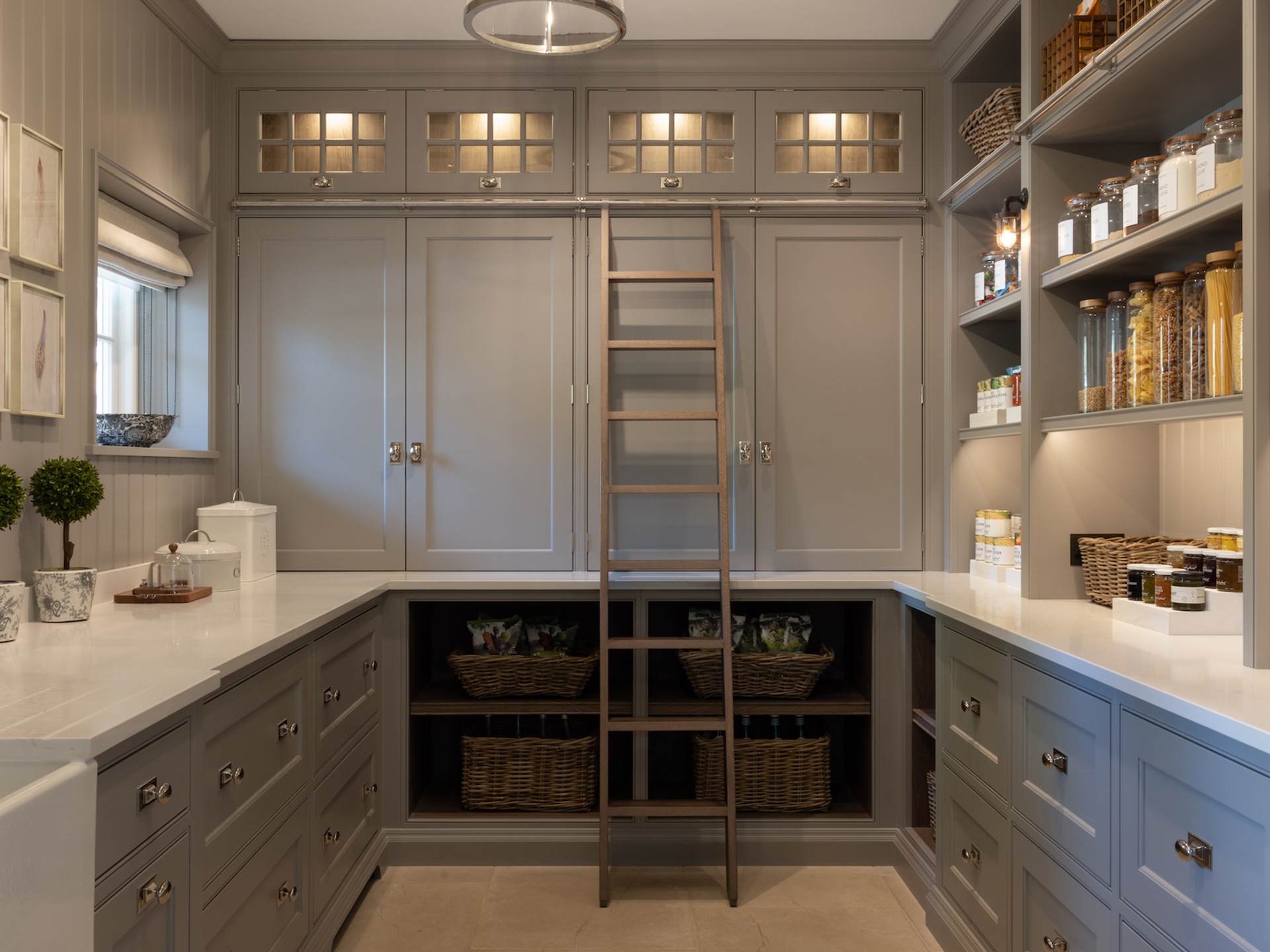
Image credit (also main image): Paul Craig for Humphrey Munson
Alex Main of The Main Company points out, “Kitchen storage is personal. Every household will differ, so it’s important to consider first what you will be storing before you design your larder or pantry. If you need space for wine, for example, think about integrating some dedicated wine shelving into your larder.”
Open shelves
For many people, part of the joy of having a pantry is the fact it has a door that you can close, hiding a multitude of messy sins. As Alex Main puts it, “Pantries and larders give you the opportunity to have some open shelving without worrying about everything being on display. Open shelving is ideal for easy access and storage. Hidden behind a larder door it ensures your kitchen remains clutter free.”
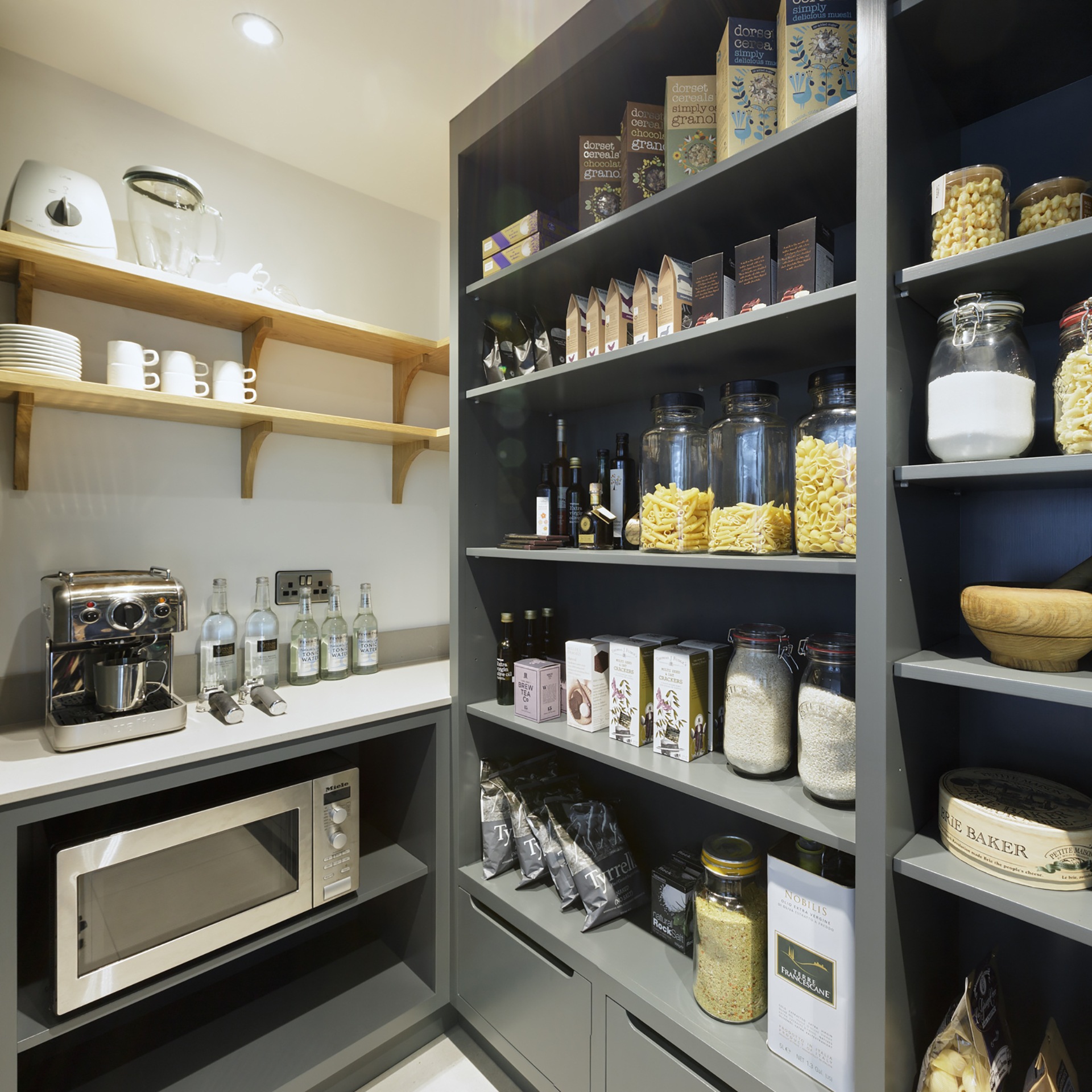
Image credit: Mowlem & Co
Josie Medved, at Symphony, agrees, “If the pantry isn’t going to be seen from outside, then a series of open, wrap-around shelves on brackets is probably all that’s required. Vary the heights of the shelves so large items like small appliances and bottles can be accommodated, and bear in mind that they will get dusty so will need regular cleaning.”
Sebastian Aronowitz, from The London Kitchen Company, says, “I’d advise oak shelving as it can withstand the weight of numerous products – shelving that’s used in kitchen cabinetry may warp over time. Plus, the oak makes it more of a dramatic feature.”
Louisa Eggleston adds, “For a walk-in pantry, you could also choose open-fronted countertop cupboards. Doors aren’t a great idea as a pantry is typically a small room and they can get in the way. The nostalgia of a walk-in pantry is conjured up from walking in and seeing everything in front of you, and this effect would be lost entirely by shutting it all away behind cupboard doors.”
Space-saving doors
Space is often tight in a pantry so Nadine Chadwick, from Nolte Kitchens, recommends pocket doors- sliding doors that disappear into a ‘pocket’ or compartment in the wall ,as a space-saving choice for a pantry. Bifold interior doors can also work well, and, on cabinets, up-and-over, tambour and slide-and-hide doors are all great space-savers.

Image credit: Kitchens by Holloways
Sebastian Aronowitz, advises, “Allow for ventilation by adding a few small holes to the door – these could be a deliberate pattern so it becomes a practical design feature.” Another door trend, which is undermining the “bung it all in the pantry and shut the door” approach, is the fashion for glass doors. These look great and let in lots of light, but offer no hiding place for mess.
Lighting
What about lighting? Louisa Eggleston says, “The lighting rule that applies in the pantry is simple enough: one circuit for task lighting, and one for accent lighting. If you have space, wall lights are always a lovely addition.”
Jen Nash from Magnet adds, “Putting lights below open shelving is a great way to open up the wall space in a smaller room, and also allows you to showcase your treasured possessions.” Motion-sensor lights are great inside pantries.

Image credit: Ledbury Studio
Pantry organisation
With #pantryorganising trending often on TikTok, it’s clear lots of people find it therapeutic to watch people organise a pantry properly, although you have to wonder how many of these viewers have kitchen storage that would stand up to social-media scrutiny… Laura Price points out, “A well-organised pantry not only makes it easier to find what you need, but also saves time, streamlines the cooking process, and helps avoid wasting ingredients due to expiration.”
Looeeze Grossman of The Used Kitchen Company, says, “Reserve eye-level spots for your daily go-to’s, so the hunt for your essentials is easy. Opt for clear glass jars in various sizes, labelled for ease, for cereals, flour, rice and pasta, and smaller ones for nuts, seeds and grains. This avoids the spillage of open packages. It’s nice to put snacks like crisps, sweets, and biscuits into chic baskets. Keep cans and jars at the back, and the shorter shelf-life items up front to prevent waste. Place taller, bulkier items on the higher shelves.
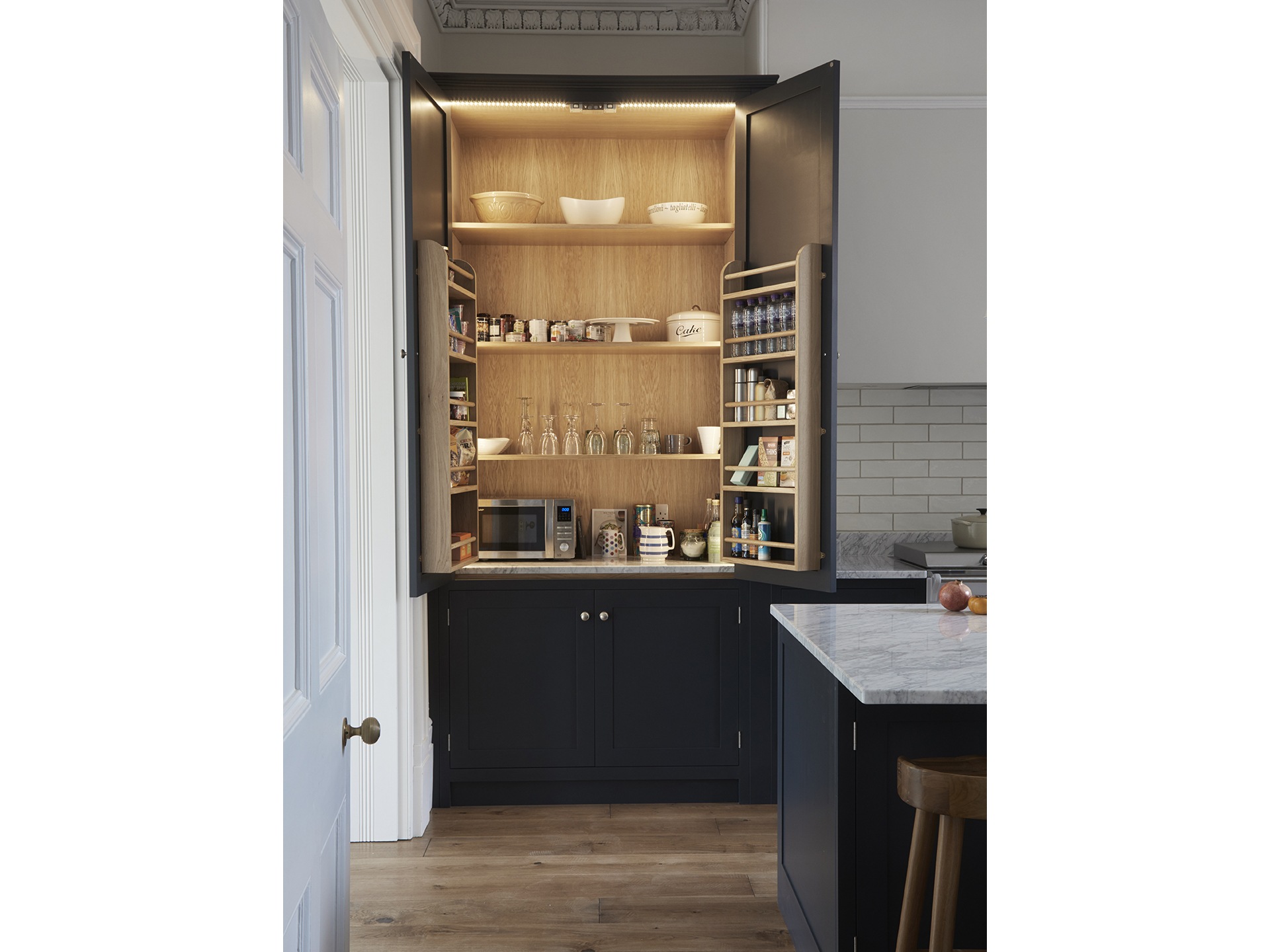
Image credit: Olive & Barr
“It’s not recommended to keep a fridge in your pantry, even if you have the space for it. This is because it keeps a pantry quite warm, and it will be less easy to access refrigerated foods while cooking.”

Image credit: Willis & Stone bespoke handcrafted kitchens
Storage solutions
Laura Price says, “Acrylic pantry bins can transform how you use your pantry. They’re great for lots of reasons: durable and easy to clean, stackable, and perfect for taller shelves. They come in lots of different sizes so you should be able to find ones to match the width and depth of your storage. Then everything will be easy to access and won’t get lost at the back. Stackable canisters can also help you use the full height of your shelves. In a small kitchen, square-based canisters help make the most of every inch. I love Brabantia’s square jars.

Image credit: Tom Howley
“Shelf risers are perfect if you have tall shelves and feel like you’re not getting the most out of them. They work by adding an extra shelf so you can store more items. Wooden boxes are perfect for storing fresh ingredients like onions and potatoes. Storing these in plastic can sometimes make them sweat, so it’s better to store them in natural-fibre containers.”
“Editing isn’t a once-and-done thing. Regularly look through your pantry to check for expired items. In a small kitchen there’s just no room for things you don’t use, so get rid of them.”

Image credit: Laura Ashley kitchen collection
Violeta Stoyanova, from Fantastic Services says, “Over-the-door organisers utilise the back of the pantry door for additional storage. Lazy Susans are perfect for corners and hard-to-reach areas.”
Hooks are great too, with woven bags or even simple string bags to store lightweight but bulky items, such as spare kitchen rolls or crisps. Another way to revolutionise your storage is with a vacuum-sealing system, such as Zwilling’s Fresh & Save Cubes. This will help you extend the shelf-life of supplies and manage your store cupboard using an app.

Image credit: Zwilling Fresh and Save
Decorganizing
Jen Nash from Magnet explains, “The growing trend of ‘decorganizing’ means your larder or pantry doesn’t have to become another dumping ground. Instead, it could be a Pinterest paradise.”
Al Bruce of Olive & Barr says, “Creating a scene that is aesthetically pleasing and simple to navigate is key. Consider choosing storage containers and mason jars that tie in with the rest of your kitchen to complete the look.”
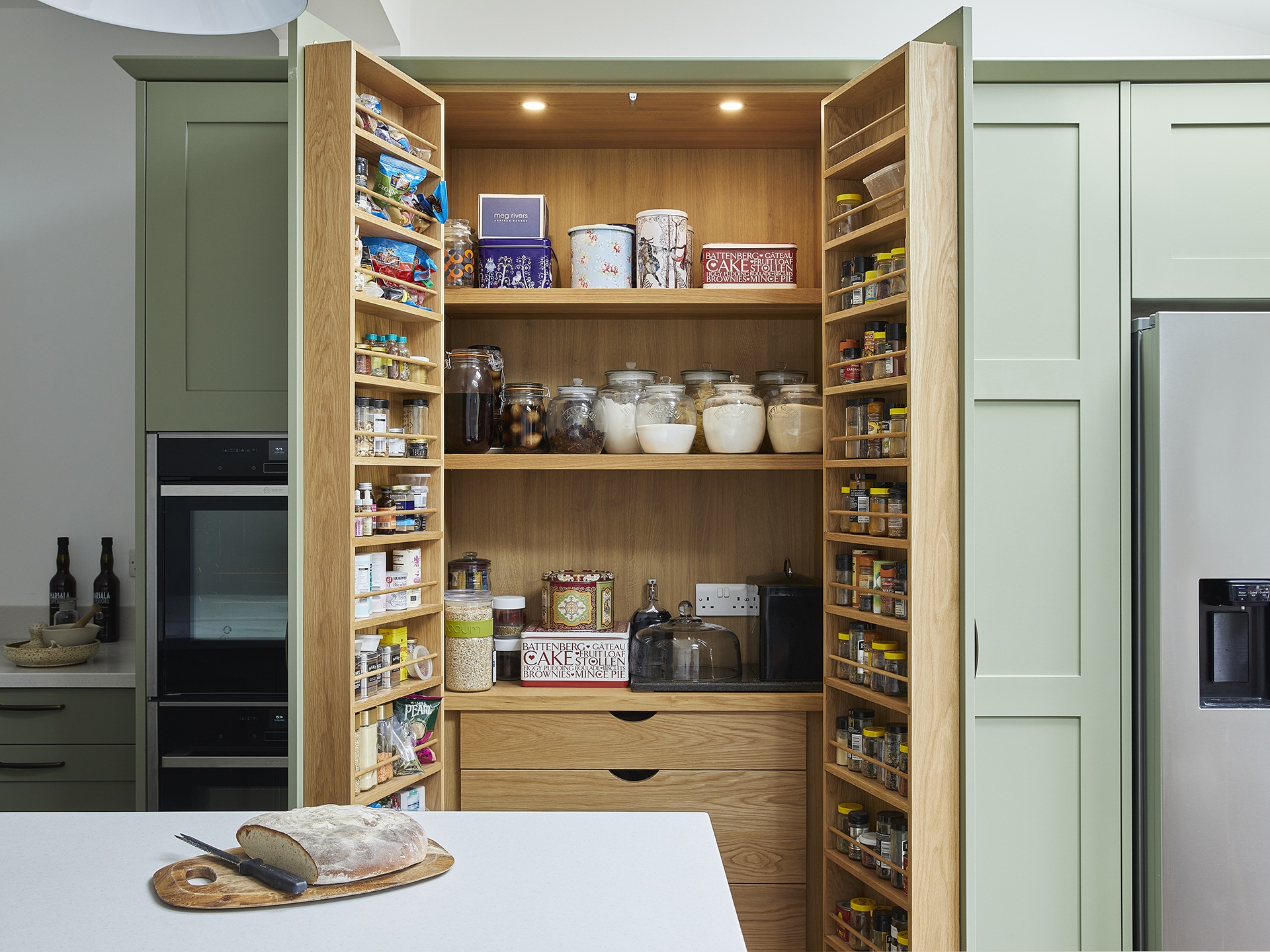
Image credit: Chris Snook for London Kitchen Company
Looeeze Grossman suggests, “Don’t be afraid to add a bit of personality to your pantry either. Add some flair with a chalkboard for grocery lists, or even a gallery wall of recipe cards.”
Louisa Eggleston says that you should “choose bolder colours and interesting floors in a pantry, a little bit like in a guest WC – you can be braver with design choices”.

Image credit: Symphony
Julia Brown from Mowlem & Co asks, “Why not make this space as beautiful as the rest of the kitchen? Then your pocket doors can stay open, or your fluted glass or Crittall doors to the walk-in can be backlit as an accent feature. We have created glam pantries with mirrored splashbacks, custom stains, luxe stones and thoughtful lighting.”
Josie Medved recommends, “bolder hues, such as indigo and cranberry, for adding personality and flair to the pantry”.

Image credit: Laura Ashley kitchen collection
Freestanding vs built-in
If you don’t have the space for a separate pantry, look at freestanding or built-in pantry options within your kitchen. Al Bruce explains, “There are positives to both freestanding and built-in pantries. Freestanding larder units encompass everything from storing your dry food and harbouring electrical goods to the full tea station with a hot tap. They have become the ‘must have’s’ of any kitchen. Long-lasting and versatile, freestanding larders can be repositioned during a kitchen remodel or packed up and transported if you move home.

Image credit: Oak Furnitureland
“The benefit of a built-in design, on the other hand, is its sleek, stylish appeal. Ideal for filling an awkward space, these tall units are perfect for smaller kitchens as they use all the available wall space while enhancing storage.
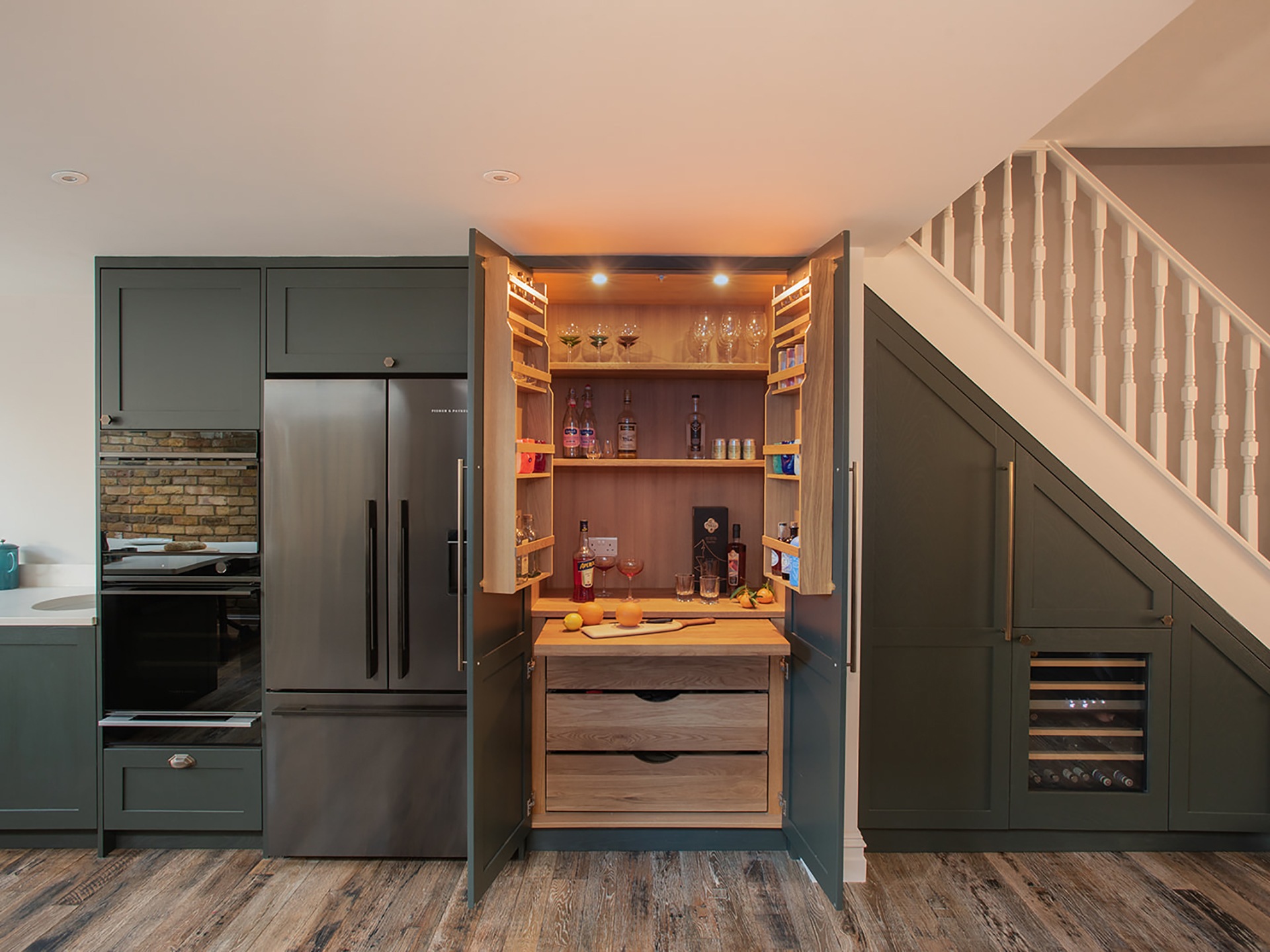
Image credit: Alexandria Hall for London Kitchen Company
“A pantry can add dimension and depth to your kitchen, removing the need for upper cabinetry and allowing light to flow through the space, opening up the possibility of open shelving instead. So, for a storage solution that blends seamlessly with your kitchen cabinets, consider a made-to-measure unit. Aside from it complementing your cabinet run perfectly, by opting for a bespoke unit, you can create a configuration that works for you, whether that means extra shelves or integrated drawers.

Image credit: Nolte kitchens
“To retain cohesion, paint your pantry in the same colour as your existing cabinets, or, to create more of a contrast, add a pop of colour.”

Image credit: Magnet
Laura Price adds, “Cabinet pantries are ideal for kitchens with limited space. They can be designed to fit seamlessly into your kitchen and make the most of vertical storage. A cabinet pantry keeps essentials within easy reach, making it convenient to grab ingredients while cooking. Shelves, pull-out drawers, and adjustable compartments can all be customised to suit your specific needs, and ensure every inch of space is utilised.”
She continues, “Pull-out pantries, meanwhile, are perfect for narrow spaces. Using sliding mechanisms to provide easy access to items stored at the back, they improve visibility and organisation.”

Image credit: Bakehouse Kitchens
Pantries with a purpose
As Al Bruce points out, a big trend in kitchens is countertop cupboards with a designated purpose, eg breakfast cupboard, baking cupboard or drinks cupboard. These can be seen as pantries with a purpose. Tom Howley, of Tom Howley kitchens, says: “As the kitchen has become a multi-purpose hub not just for cooking, but also relaxing, working remotely and hosting friends and family, the need to keep this space more organised has increased. Introducing hidden elements, such as a breakfast pantry, can make all the difference. A breakfast pantry can be designed to incorporate your entire morning routine, from a professional coffee machine, toaster, storage for everyday crockery, and a whole host of cereal options for the kids. The best thing is that, once you’ve had enough, you can close the doors behind you, concealing all the mess and clutter until it’s time to tidy.”

Image credit: Second Nature
Sustainability
Sustainable options include using recycled shelving or preloved pantry units from companies such as The Used Kitchen Company. If you’re buying a new kitchen, ask suppliers whether their wood is from a sustainable source, how much waste is generated in the manufacturing process, and whether they use paint that gives off trace/low volatile organic compounds (VOCs). Choose the best quality kitchen you can afford as it will last longer, and pick a design that won’t date quickly.

Image credit: The Used Kitchen Company









